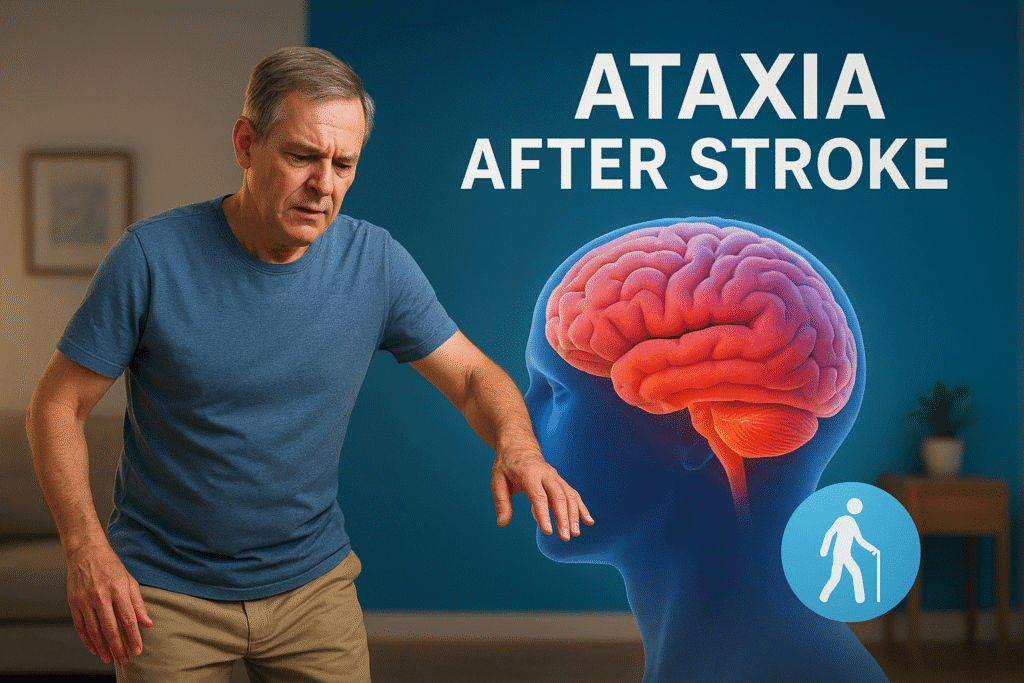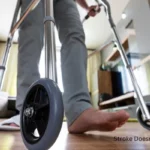Ataxia After Stroke: Understanding, Managing, and Moving Forward
Yes, ataxia can occur after a stroke. It affects balance and coordination, making movements feel unsteady or shaky. Recovery varies from person to person, but improvement is possible with time and proper therapy. For a better understanding and helpful guidance, please go through the details below.

After a serious brain event, many people notice sudden weakness, unclear speech, or memory gaps. For many survivors, one lasting and deeply frustrating challenge involves shaky coordination and poor balance. Simple routines—walking along a hallway, using utensils during a meal, or buttoning a shirt—can suddenly feel overwhelming.
This difficulty shows up when signals between brain and muscles do not travel smoothly, causing movements to feel jerky or off-timing. Progress often takes patience, yet focused exercises, movement retraining, and steady practice can slowly restore control and steadiness. As coordination improves, daily routines become easier, independence grows, and confidence begins to return.
What Exactly Is Ataxia?
This condition does not stand alone as an illness. Instead, it describes a group of movement challenges that change how muscles respond. Picture an airport where a control tower guides every flight. When messages from that tower become mixed up, planes struggle to take off, land, or find proper direction. In a similar way, when communication inside nervous pathways breaks down, muscles have trouble producing smooth, coordinated motion.
Some common difficulties that may emerge include:
Movements that appear awkward, shaky, or unsteady when walking or changing positions
Difficulty completing precise tasks such as writing, fastening clothing, or using utensils
Trouble maintaining balance while standing still
Speech that may sound slowed, slurred, or harder to follow
Eyes that drift or move in unexpected ways, making focus more challenging
When these issues arise following injury to the nervous system, they often stem from damage to regions responsible for fine-tuning movement and sending clear signals to muscles. This interference disrupts smooth execution of actions, resulting in unsteady movements, coordination problems, and changes in speech that are commonly observed.
How Stroke Causes Ataxia
When blood flow to part of a nervous system is interrupted—either by a blocked vessel (ischemic) or a ruptured one (hemorrhagic)—effects depend on which region is involved. If areas responsible for refining movement are affected, shaky or unsteady motions often appear.
It isn’t only about direct involvement of movement-control centers. Even when main coordination regions remain intact, problems can arise if communication pathways connecting higher centers to spinal circuits are damaged. For instance, if stem of a nervous system is impacted, signals may fail to reach intended destinations, producing stumbling, swaying, or awkward motions similar to disruptions in fine-tuning regions.
Important point: this condition isn’t caused by weak muscles. Strength may remain normal, yet smooth, coordinated motion can be lost. Someone might have powerful legs but still drift from side to side or struggle to move in a straight line, showing how coordination and strength function separately in movement control.
Symptoms to Look Out For
This condition appears differently for each individual. For some, it may seem like occasional clumsiness, while for others, movements may feel unpredictable or difficult to control. What makes it challenging is that patterns can change from day to day—sometimes actions feel manageable, and at other times, even simple tasks can become tiring or frustrating.
Common ways it tends to appear include:
Trouble with Steps and Movement
Moving from one place to another can feel as if ground itself is shifting. Steps may wobble, legs may stagger as though unsteady, or limbs may refuse to respond as expected. Even remaining in one spot for a while can feel precarious, like trying to balance on a gently rocking boat.
Arm and Hand Challenges
Everyday tasks often taken for granted—grabbing a glass, tying shoelaces, or lifting a pen—can become challenging. Hands or arms may overshoot, undershoot, or tremble unexpectedly. Picture trying to thread a needle while fingers refuse to stay steady; this illustrates struggles many encounter regularly.
Speech Changes
Speech may no longer flow as smoothly as before. Words can sound slurred, slowed, or fragmented, almost like a skipping record. Volume might drop unexpectedly, and sentences may come out uneven, making conversations frustrating for both speaker and listener.
Eye Movement Difficulties
Vision can also be affected. Eyes may dart rapidly, jerk unexpectedly, or struggle to stay focused on a single point. This can make reading, tracking moving objects, or maintaining eye contact during conversation difficult. Consequences may include dizziness, blurred sight, or a spinning sensation that disrupts balance and orientation.
Unpredictable Nature
One of toughest parts comes from unpredictability. One morning may start with smoother, more controlled movement, then next day makes walking, reaching, or gripping feel nearly impossible. It feels like living by shifting rules—what works today may fail tomorrow. That uncertainty can drain energy just as much as physical struggles do.
For many, symptoms can fluctuate—one day balance feels steady, and next, even simple movements may become nearly impossible.
How Ataxia Is Diagnosed
After an event like this, specialists take several steps to understand how movement and coordination may have been affected. Evaluation usually begins with a thorough physical check, observing how arms and legs move, how steady steps are, and how reflexes respond.
If speech becomes unclear or difficult to produce, language and voice assessments may be performed to see how communication has changed.
Imaging tools such as CT or MRI scans are often used to identify which parts of a nervous system were impacted. These scans provide insight into where disruption occurred and guide next steps for recovery.
Eye examinations are also common, since irregular visual movements can interfere with daily activities and balance.
Early identification of these changes allows specialists to plan strategies that improve coordination, functional independence, and overall confidence in everyday tasks.
Can coordination improve after a brain event?
Recovery is very much within reach. A human nervous system has an impressive capacity to adapt after injury. Scientists call this natural flexibility “neuroplasticity.” Essentially, systems can find new pathways and form fresh connections so functions once managed by damaged areas can be taken over elsewhere. Imagine a city rerouting traffic—when one street closes, other routes open to keep movement flowing.
Key point: renewal doesn’t happen automatically. Steady effort, repetition, and patience are needed to encourage new pathways to strengthen. It’s like learning a new skill—mastery doesn’t happen overnight. Consistent practice allows systems to “remember” how to perform certain actions again.
For some, changes appear quickly—within a few months, noticeable differences in daily activity may emerge. For others, progress is slower, more like a long climb than a sprint. Each person’s journey is unique, and while pace varies, small achievements often accumulate into larger breakthroughs. Even when progress stretches over years, potential for improvement continues.
This path takes grit and patience, yet it brings hope knowing systems can keep moving forward. Recovery isn’t instant—it grows through steady steps, regular practice, and quiet, ongoing effort happening day by day.
Treatment Options After Coordination Changes From a Brain Event
Right now, there isn’t a single pill that can completely reverse this condition. But a mix of different approaches often makes life a lot easier and helps people function more independently. Care plans typically involve:
Movement Training
Specialists work one-on-one with individuals to help them regain smoother control of their body. Sessions may include:
Learning how to shift weight from side to side or move steadily between obstacles
Building muscle strength through targeted drills
Practicing hand-to-eye activities, like repeatedly guiding a fingertip toward one’s nose
Daily Living Support
Experts in this area focus on helping people manage everyday activities—things like eating, dressing, cooking, or handwriting. To make these tasks simpler, they may recommend adaptive tools such as weighted forks and spoons, clothing aids like button hooks, or customized grips for pens.
Speech and Communication Guidance
For those whose speech becomes slurred or harder to control, language specialists can step in. They teach pacing strategies, breathing methods, and clear pronunciation techniques to help communication feel less frustrating and more natural.
Medications
While no medication directly removes this condition, some prescriptions can reduce related challenges. For example:
Clonazepam can reduce tremors
Baclofen may improve muscle control
Gabapentin is sometimes used when body coordination feels off
Supportive Equipment
Mobility aids like canes, braces, or walkers can make moving around safer and steadier. In some cases, custom eyewear can improve vision challenges that come with this situation.
Rehabilitation Exercises You Can Try
If movement practice at home has been recommended, here are a few gentle routines to try (always get approval from a specialist first):
Heel-to-Toe Line Steps – Imagine moving along a tightrope. Set heel of one foot right in front of toes on other foot, then step forward slowly in a straight line. This builds steadiness, balance, and smoother control with each step.
Seated Leg Raises – Sit comfortably on a sturdy chair. Lift one leg off ground, hold for a few seconds, then lower slowly. Switch sides and focus on controlled movement rather than speed.
Reach-and-Grasp Practice – Arrange a few small objects on a table. Slowly reach, pick one up, bring it closer, then set it back down. Rotate through different items to challenge precision and control.
Gentle Weight Shifts – Stand with feet shoulder-width apart. Without lifting feet, lean weight slightly to one side, return to center, then repeat on opposite side. Move slowly to improve steadiness and awareness of posture.
Consistency is key. Repeating these movements regularly encourages nerves and muscles to adjust, learn, and form new patterns over time, gradually improving coordination and control.
Living With Ataxia: Practical Tips
Aside from medical guidance, there are simple changes you can make in your everyday routine that really help with comfort and safety:
Create a safer environment – Remove loose rugs, install grab bars in bathrooms, and ensure hallways and rooms are well-lit to reduce risk of tripping or stumbling.
Move deliberately – Rushing often leads to slips or accidents. Allow extra time and focus on steady, controlled movements.
Keep moving – Gentle activities such as yoga, stretching, or swimming help maintain flexibility and overall strength, making everyday tasks easier.
Use practical tools – Specially designed utensils, sturdy mobility aids, or communication devices can make tasks smoother and reduce frustration.
Practice patience – Progress may feel slow, but even small improvements accumulate over time. Every step forward counts and deserves recognition.
Emotional Impact After Loss of Coordination From a Brain Event
Struggles aren’t only physical—they can affect emotional well-being too. Losing ability to move as before often brings frustration, embarrassment, or sadness. It’s not just about changes in movement; it’s also about adjusting mentally to a new way of living.
Emotional resilience can be strengthened in different ways:
Connecting with others who share similar experiences and understand challenges firsthand.
Speaking with a trained counselor to work through feelings that may feel overwhelming.
Sharing information with family or close friends so they can be patient, understanding, and encouraging during difficult days.
Recovery isn’t only about restoring movement—it also involves building emotional strength and finding peace. Both aspects are important, and addressing inner struggles can be just as meaningful as practicing coordination and control.
Research and Future Outlook
Researchers are exploring new ways to support recovery from movement difficulties after injury to a nervous system. Some promising approaches include:
Virtual reality programs – Interactive systems allow practice of everyday motions in safe, engaging settings. Playful challenges encourage repetition, which can strengthen coordination over time.
Robotic assistance systems – Specialized machines guide arms or legs through repeated motions, giving nerves a chance to “relearn” patterns without added strain. This steady practice can promote gradual improvement.
Stimulation methods – Gentle electrical or magnetic pulses are being tested to activate nerve pathways, encouraging adaptation and formation of new connections.
While these approaches continue to develop, early results suggest they may smooth progress and shorten journey toward greater independence in years ahead.
Key Takeaways
After an injury affecting a nervous system, one common after-effect is a loss of smooth movement control. Instead of steady steps or fluid hand motions, a person may feel shaky, move in a jerky way, or struggle to guide limbs as intended. Even simple tasks—lifting a glass, walking across a room—can feel unpredictable.
This condition can also affect speech. Words may come out slurred, sentences harder to form clearly, and rhythm of talking may feel off. For some, eyes may not coordinate properly, causing blurred vision or a sense of dizziness. Together, these challenges impact daily life, affecting independence and how a person connects with others.
Recovery takes time and often involves a combination of strategies. Specialists may recommend guided movement practice, tools that make everyday tasks easier, and structured routines that help systems relearn control. Many people find benefit in supportive devices—canes, weighted utensils, or adaptive technology—that reduce difficulty in daily activities.
Emotional effects can be just as significant as physical ones. Feeling unsteady or unable to trust movement often brings frustration, sadness, or anger. Encouragement from family, friends, and trained professionals can make a difference. Conversations, counseling, and peer connections often provide motivation to keep progressing, even when improvements feel slow.
Researchers continue exploring new ways to improve outcomes through innovative equipment, targeted training programs, or advanced interventions. Each development offers potential to give people better tools to regain coordination and confidence in daily life.
Final Word
Living with movement challenges after a major neurological event can feel like climbing a mountain barefoot. Journey feels tough, frustrating, and full of setbacks, yet it does not end there. Progress often shows up in small gains instead of big leaps, but every step matters. Each guided session, every moment spent practicing new skills, and each small win builds over time. With steady guidance, consistent effort, and determination, many people regain independence and discover new ways to manage daily life.



